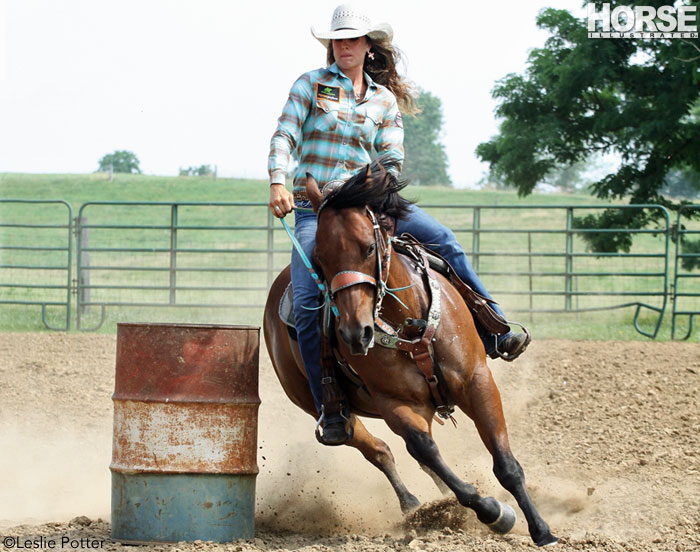
Fallon Taylor of Dynasty Equine in Whitesboro, Texas, is a five-time National Finals Rodeo qualifier and trainer of the American Quarter Horse Association 2013 Horse of the Year, Babyflo.
“If you’re having trouble with that first barrel, it could set you up to have trouble at the second and third,” Taylor says. Here, she offers tips for riding a good approach to the first barrel and explains how to troubleshoot common problems.
Setting Up for Success
When schooling for a good barrel run at home, maintaining consistency and keeping it fun are important, says Taylor. You don’t want to just drill your horse around the first barrel over and over again.
“That first barrel needs to be somewhere a horse wants to go,” explains Taylor. Her horse’s daily arena workouts may only last 10 to 15 minutes. “If I’m working on patterning a young horse, I’m going to walk through the pattern a few times, trot it, lope it maybe once or twice, and then to reward my horse, I typically walk to the first barrel, step off and undo the cinch,” she says. This rewards him for a job well done and makes going to the first barrel a good thing. Taylor even likes to unsaddle her horses after a training session and let them play and roll in the arena so that it’s a nice place to be.
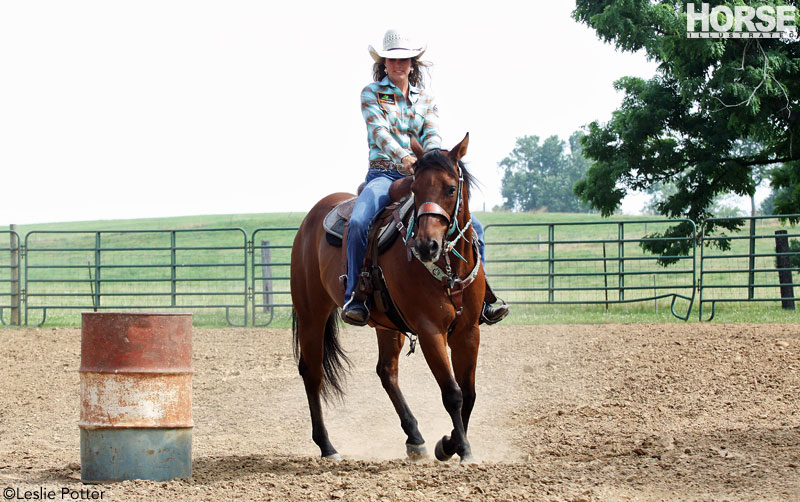
Variety is also integral in training to keep your horse from getting stale. Taylor’s key exercises away from pattern work include riding figure-eights and doing rollbacks, and for finished horses a workout may focus on a specific issue. Each session is carefully tailored to the particular horse, says Taylor, who also likes to make sure they spend time outside the arena.
“Not making the arena their main work is really great for horses’ minds, especially barrel horses,” Taylor says. “If you take them away from the pattern, they’re able to stay more level-headed.”
Trail rides are a great supplement to arena work, as are cool-downs outside the ring. “After you’re done working the pattern in the arena, take your horse out for 10 or 15 minutes,” says Taylor. “Ride around and just enjoy it. Let him breathe and walk. That’s a big deal.”
Every Horse is Different
Taylor emphasizes that each horse has different strengths, and that how horses run the pattern—and even the angle at which they approach each barrel—will vary.
“You might have a really ratey horse, where you need to pay attention to your timing as a rider,” explains Taylor. The issues will be different for a horse that is more forward.
Common Problems
Typically, an ideal turn should resemble a tear-drop shape. Common problems with the first barrel can include crowding or knocking down the barrel, and going too fast or too slow while approaching or leaving the barrel.
“If the horse is shouldering the barrel, you need to walk the barrel pattern and really pick up that inside rein,” Taylor says. “So when you are approaching that first barrel, focus on sitting when your leg gets to that barrel. As you sit, especially at a walk, always exaggerate your movements. Even at a walk, remember to grab the horn with your outside hand.” Your inside hand will lift the horse’s shoulder by bringing the inside rein toward your inside pocket, not lifting it up or out.
“Leaving that barrel is just as important as how you approach it,” Taylor continues. “Push your hands up toward your horse’s ears as you complete your turn and drive to the pocket of your next barrel.”
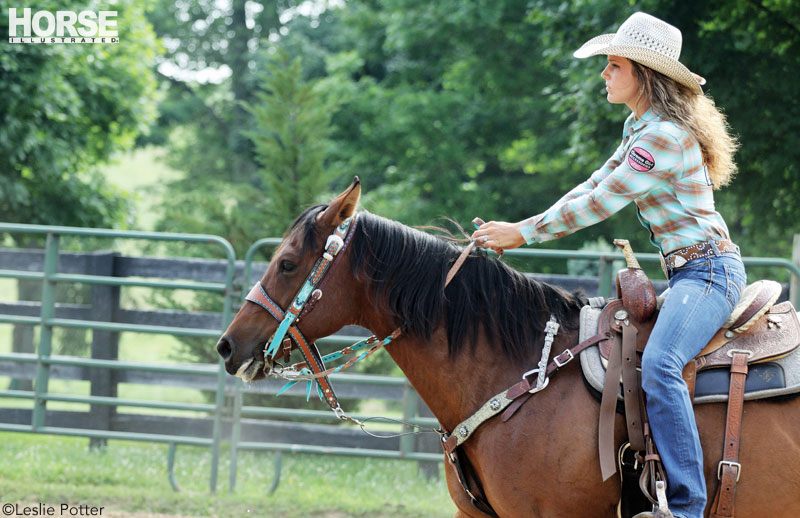
Your horse will learn at slow speeds, so don’t try to run the pattern as you work through the issue. “Slow it down, break it down, and really make sure your hands and body position are rodeo-ready on every single walk, trot and run,” says Taylor. “Horses learn your body, so if you sit, you need to make sure that your horse knows that it’s time to turn. Sitting when your leg gets to that barrel is super important. With shouldering, you have to make sure you lift that inside rein and get an arced angle—a nice tear-drop shape.”
Leg cues will depend on your horse’s body position in the turn. “If you have a horse that is not bending at the ribcage, you can take your inside foot and bend him at the ribcage—just a slight bump for some horses, or it could be a steady pressure,” explains Taylor.
If your horse is hitting the barrel with his hip as you leave the barrel, you need to make sure you’re giving him the proper pocket to make the turn. “Clear your leg, clear his hip, and then start to run,” Taylor says.
For horses that are turning too wide, she also recommends going back to slow work. “Really slow down and make sure you have the right amount of space between you and the barrel,” she explains. “Focus on that pocket. I say it’s around 4 or 5 feet depending on how big or small your horse is.”
If your horse is going into or out of the turn too slowly, Taylor suggests really opening him up and letting him run outside the arena. “Take your horse to a big field and let him know he can run,” she says. “Some horses don’t know they can run. Take him to a racetrack or field, somewhere you’re not going to injure yourself or your horse, and let him open up and just run. If you open them up, they realize what they’re capable of, and it really helps when you apply it to the barrel pattern.”
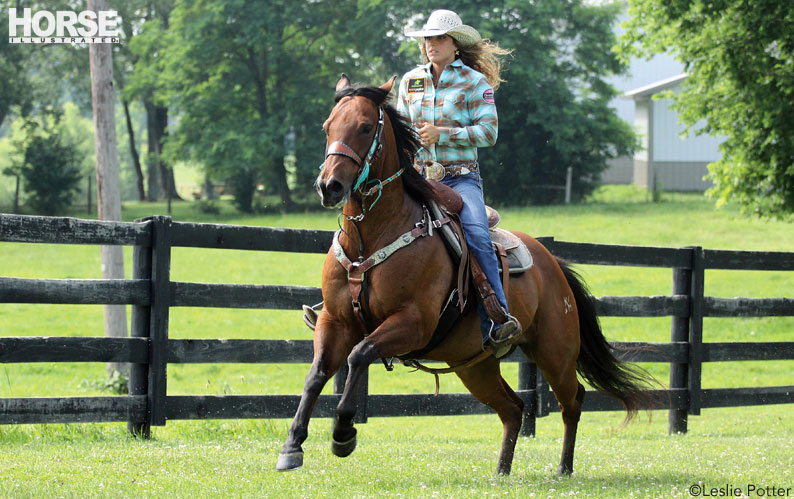
On the other hand, horses that are all speed need to learn to rate. For this, Taylor recommends an exercise that involves the horse dropping his gait around each turn. “If you’re loping the pattern in practice, when you get to the barrel, slow down and trot around it,” she says. “Go back to a lope and trot the second barrel, and so on. Break it down for them so they realize they have to slow down for the turn.”
Taylor advises against too much stopping and backing up. “One common rider mistake I see is not enough forward motion,” she says. “I also see not enough hind-end engagement, meaning the horse doesn’t know how to use his motor on the back side; he doesn’t know how to get his legs underneath him. My suggestion for that is rollbacks in the arena.”
Taylor recommends videoing your runs when you’re having issues so that you can pinpoint exactly what’s going wrong and where. “Go back and pay attention to your timing and what your horse is doing,” Taylor says. “If you’re knocking the first barrel, it could be a shoulder, a hip on the back side, your leg, or that you’re coming in too close or preparing for your turn too soon.” Once you pinpoint the problem, you can work on tackling it more specifically.
Through it all, remember to reward your horse and slow down. “Don’t ever forget to reward your horse,” Taylor says. “It’s vital to his training, and it’s good for his mind to really slow down sometimes.”
Liked this article? Here’s more info on barrel racing:
Rating Your Run
Barrel Essentials
Barrel Racing Troubleshooter
Special thanks to Kelly Murphy-Alley and her AQHA gelding, Cruz, for demonstrating these exercises.
MICAELA MYERS is the author of The Horse Illustrated Guide to Trail Riding (BowTie Press) and KNACK Leg and Hoof Care for Horses.
This article originally appeared in the September 2014 issue of Horse Illustrated. Click here to subscribe!

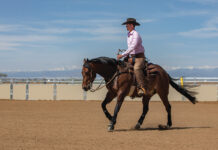
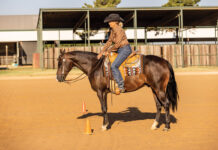
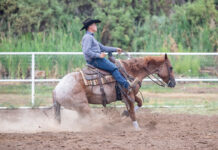

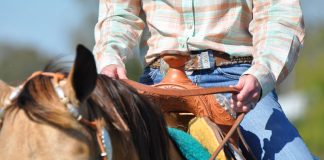

great info!
I just read this in HI! I guess I’m a bit behind in my issues.
Great article.
good article I’m not a barrel racer but like to understand those that are racing what they are doing